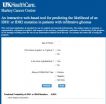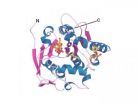(Press-News.org) new web-based program developed by University of Kentucky Markey Cancer Center researchers will provide a simple, free way for healthcare providers to determine which brain tumor cases require testing for a genetic mutation.
Gliomas – a type of tumor that begins in the brain or spine – are the most common and deadly form of brain cancer in adults, making up about 80 percent of malignant brain cancer cases. In some of these cases, patients have a mutation in a specific gene, known as an IDH1 mutation – and patients who have this tend to survive years longer than those who do not carry the mutation.
The program, developed by UK researchers Li Chen, Eric Durbin, and Craig Horbinski, uses a statistical model to accurately predict the likelihood that a patient carries the IDH1 mutation and requires screening. Healthcare providers need only answer four questions in the application.
Gliomas are often tested for IDH1 mutation following surgery to remove the tumor, but undergoing this type of testing often requires stringent insurance pre-approvals due to rising healthcare costs, Horbinski says.
"Currently, there are no universally accepted guidelines for when gliomas should be tested for this mutation," Horbinski said. "Obtaining insurance pre-approval for additional molecular testing is becoming more commonplace, and this program will assist healthcare providers with an evidence-based rationale for when IDH1 screening is necessary."
Additionally, Horbinski notes that the program will help conserve research dollars by helping brain cancer researchers narrow down which specific older gliomas in tumor banks – previously removed in a time before IDH1 testing was routine – should be tested as data for research projects.
INFORMATION:
Horbinski's research on the program was published in the May issue of Neuro-Oncology. The work was funded through a grant from the National Cancer Institute, the Peter and Carmen Lucia Buck Training Program in Translational Clinical Oncology, and the University of Kentucky College of Medicine Physician Scientist Program.
Markey researchers develop web-based app to predict glioma mutations
2014-08-19
ELSE PRESS RELEASES FROM THIS DATE:
Philippine tarsier gets boost from Kansas research, and genetic proof of a new variety
2014-08-19
LAWRENCE — It's not a monkey. It's not a lemur. It's not an African Bush Baby or even a Madagascan Mouse. Meet the Philippine tarsier: a tiny, adorable and downright "cool" primate from Southeast Asia.
"It's really not like any animals that Americans are familiar with," said Rafe Brown, curator-in-charge at the University of Kansas' Biodiversity Institute. "A tarsier has giant eyes and ears; an extremely cute, furry body; a long tail with a furry tuft at the end; and interesting expanded fingers and toe tips that look a bit like the disks on the digits of tree frogs."
Brown ...
New vaccine shows promise as stronger weapon against both tuberculosis and leprosy
2014-08-19
In many parts of the world, leprosy and tuberculosis live side-by-side. Worldwide there are approximately 233,000 new cases of leprosy per year, with nearly all of them occurring where tuberculosis is endemic.
The currently available century-old vaccine Bacille Calmette-Guerin, or BCG, provides only partial protection against both tuberculosis and leprosy, so a more potent vaccine is needed to combat both diseases. UCLA-led research may have found a stronger weapon against both diseases.
In a study published in the September issue of the peer-reviewed journal Infection ...
Seafood substitutions can expose consumers to unexpectedly high mercury
2014-08-19
New measurements from fish purchased at retail seafood counters in 10 different states show the extent to which mislabeling can expose consumers to unexpectedly high levels of mercury, a harmful pollutant.
Fishery stock "substitutions"—which falsely present a fish of the same species, but from a different geographic origin—are the most dangerous mislabeling offense, according to new research by University of Hawai'i at Mānoa scientists.
"Accurate labeling of seafood is essential to allow consumers to choose sustainable fisheries," said UH Mānoa biologist Peter ...
Engineering new bone growth
2014-08-19
CAMBRIDGE, MA -- MIT chemical engineers have devised a new implantable tissue scaffold coated with bone growth factors that are released slowly over a few weeks. When applied to bone injuries or defects, this coated scaffold induces the body to rapidly form new bone that looks and behaves just like the original tissue.
This type of coated scaffold could offer a dramatic improvement over the current standard for treating bone injuries, which involves transplanting bone from another part of the patient's body — a painful process that does not always supply enough bone. ...
Antibacterial soap exposes health workers to high triclosan levels
2014-08-19
Handwashing with antibacterial soap exposes hospital workers to significant and potentially unsafe levels of triclosan, a widely-used chemical currently under review by the U.S. Food and Drug Administration, according to a study led by researchers from UC San Francisco.
Triclosan, a synthetic antibacterial agent, is found in thousands of consumer products, including soaps, cosmetics, acne creams and some brands of toothpaste. The FDA is reviewing its safety based on a growing body of research indicating that it can interfere with the action of hormones, potentially causing ...
Solar energy that doesn't block the view
2014-08-19
A team of researchers at Michigan State University has developed a new type of solar concentrator that when placed over a window creates solar energy while allowing people to actually see through the window.
It is called a transparent luminescent solar concentrator and can be used on buildings, cell phones and any other device that has a flat, clear surface.
And, according to Richard Lunt of MSU's College of Engineering, the key word is "transparent."
Research in the production of energy from solar cells placed around luminescent plastic-like materials is not new. ...
NMR using Earth's magnetic field
2014-08-19
Earth's magnetic field, a familiar directional indicator over long distances, is routinely probed in applications ranging from geology to archaeology. Now it has provided the basis for a technique which might, one day, be used to characterize the chemical composition of fluid mixtures in their native environments.
Researchers from the U.S. Department of Energy (DOE)'s Lawrence Berkeley National Laboratory (Berkeley Lab) conducted a proof-of-concept NMR experiment in which a mixture of hydrocarbons and water was analyzed using a high-sensitivity magnetometer and a magnetic ...
Biomarker in an aggressive breast cancer is identified
2014-08-19
Two Northwestern University scientists have identified a biomarker strongly associated with basal-like breast cancer, a highly aggressive carcinoma that is resistant to many types of chemotherapy. The biomarker, a protein called STAT3, provides a smart target for new therapeutics designed to treat this often deadly cancer.
Using breast cancer patient data taken from The Cancer Genome Atlas, molecular biologists Curt M. Horvath and Robert W. Tell used powerful computational and bioinformatics techniques to detect patterns of gene expression in two cancer subtypes. They ...
Nurse staffing and mortality in stroke centers
2014-08-19
Hospital staffing levels have been associated with patient outcomes, but staffing on weekends has not been well studied, despite a recent UK mandate to make physician specialist care 7 days a week a policy and service improvement priority for the National Health Service. To help address the paucity of research on the association of weekend staffing with patient outcomes, Dr. Benjamin Bray of King's College London and Royal College of Physicians, United Kingdom, and colleagues conducted a prospective cohort study of weekend staffing with stroke specialist physicians for ...
Blood glucose levels measured in hospitalized patients can predict risk of type 2 diabetes
2014-08-19
Blood glucose levels measured in hospitalized adults during acute illness can be used to predict risk of developing type 2 diabetes over the following 3 years, according to a study published by David McAllister and colleagues from the University of Edinburgh, UK in this week's PLOS Medicine.
The researchers obtained measurements of blood glucose levels on admission for 86,634 patients aged 40 years or older who were admitted to a hospital for an acute illness between 2004 and 2008 in Scotland and identified those patients who developed type 2 diabetes up to December 2011 ...



